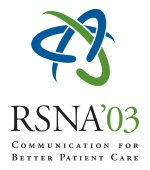Abstract:
HTML
Purpose: Evaluation of residual or recurrent tumor of neuroblastoma is important management issue in pediatric patients. By means of CT and MR it is difficult to differentiate viable neuroblastoma from scar tissue. Uptake of MIBG indicates the presence of viable tumor cells. This study was designed to evaluate the utility of I-123 MIBG scanning through the follow-up period as well as correlative anatomic imaging studies and pathology.
Methods and Materials: Imaging and clinical data of 25 children (10 girls, 15 boys) with histologically proven neuroblastoma(primary,residual and recurrent tumors as well as metastases) were reviewed retrospectively. Serial imaging studies were reviewed for all patients, including 90 MIBG scans, 122 CT scans, and 23 MR scans. The findings were related to those of other imaging studies and the histologic classification.
Results: At initial diagnosis, when compared with CT/MR, MIBG identified all suspected primary lesions that confirmed to neuroblastoma. Eleven patients with NB who had initially positive MIBG scan had normalized serial studies during therapy. 5 of 11 had relapses after therapy. MIBG were positive in all of 5 patients, whereas CT/MR demonstrated regression of mass in one and stable lesion in one, respectively. CT/MR scan discovered sites of relapses in the other three. Among these relapse sites, only one leptomeningeal disease seen on MR scan had normal MIBG scan. Fourteen of 25 with initially positive MIBG had persistent abnormalities over serial studies. Two of 14 showed partial regression on CT scan but persistent MIBG uptake during therapy. After completion of therapy, in these two, subsequent new lesions were developed on CT scan. Among 9 performed second surgery after chemotherpy, 3 confirmed to have residual NB demonstrated persistently increased MIBG uptake. Of the remaining 3 GNB and 3 GN, one of each showed normal MIBG results. After 2nd surgery for adrenal tumor, transient increased MIBG uptake was newly developed in contralateral normal adrenal region but normal imaging findings and clinical status (urinary VMA/HVA).
Conclusion: I-123 MIBG scan are useful in monitoring the therapy response and assessment of residual viable tumor through the follow-up period. However, awareness of potential pitfalls in the use of this examination may avert subsequent diagnostic and therapeutic errors.
Questions about this event email: shlgy@catholic.ac.kr
Im MD, S,
Utility of I-123 MIBG Scintigraphy for Evaluating Chemotherapy Response in Children with Neuroblastoma: Comparison with CT and MR. Radiological Society of North America 2003 Scientific Assembly and Annual Meeting, November 30 - December 5, 2003 ,Chicago IL.
http://archive.rsna.org/2003/3101753.html

